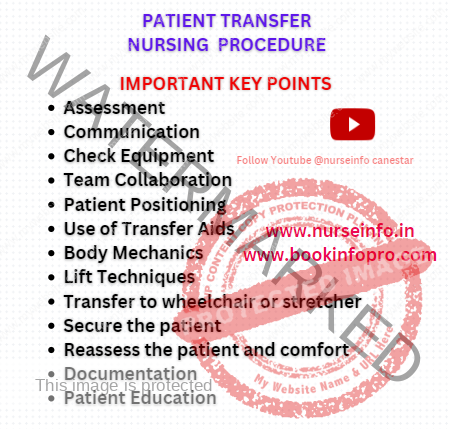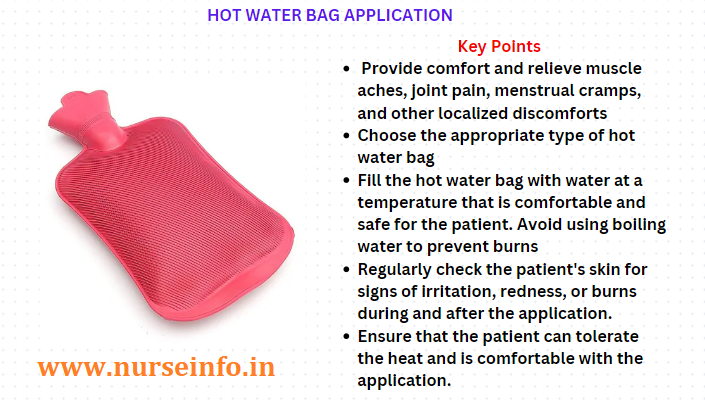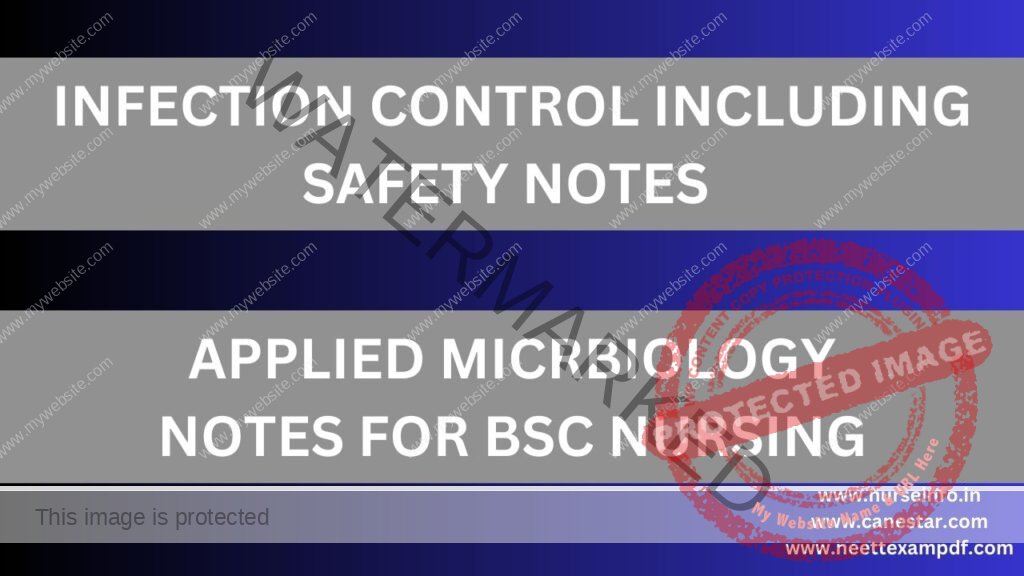Updated 2024
PATIENT TRANSFER NURSING PROCEDURE
The patient is usually hospitalized in the same department from which they are discharged. The health condition changes in some patients so much that they are transferred and treated by another department or another treatment unit of the same or different department or in the same or another healthcare facility
Definition
Transfer is defined as preparing patient, completing necessary records and shifting patient to another department within the hospital or to another hospital/home
Transfer/referral is the preparation of a patient and the referral records to shift the patient to other department within the hospital or to another hospital
Purpose
- To obtain necessary diagnostic tests and procedure
- To provide treatment and nursing care
- To provide specialized care
- To place most appropriate utilization or available personnel and services
- To match intensity of nursing care based on patients level of needs and problems

Preparation Includes
- An explanation of the transfer to the patient and his family
- Discussion of the patient’s condition and care plan with the staff at the receiving unit or facility
- Arrangements of transportation, if necessary
Types of Transfer of the Patient
- Internal transfer: to transfer the patient in a unit that provides special care or care suited to his needs, e.g. from general ward to ICU
- External transfer: to transfer the patient from one hospital to other hospital for the purpose of special care, e.g. from general hospital to specialized hospital – cancer centre
Preliminary Assessment
- Assess the method for transport, inform receiving nurse
- Maintain patient’s physical well being during transport to new nursing unit
- Provide verbal report about patient’s condition to the receiving unit nurse
- Be sure all documentation including care plan is completed
- Assist patient’s arrival to the new unit
- Announce patient’s arrival to the new unit
- Transport patient to a new room and assist in transfer to bed
- Hand over to receiving nurse
Equipment
- Wheelchair/stretcher
- Identification labels
- Patients belongings
- X-rays, investigation reports, patient record and file
Preliminary Assessment
- Check the doctor’s order for transfer of patient
- Inform the patient and relatives
- Inform to the ward sister where the patient needs to be transferred
- Check the chart for complete recording of vital signs, nursing care and treatment given
- Collect patient’s X-ray, medicine and other belongings
- Cancel the hospital diet or transfer
- Assist the relatives to collect other belongings
- Make arrangement to settle the due bills if going to another hospital
- Record time, mode of transfer and general condition of the patient
- Assist in transferring risk patient to wheelchair/stretcher and accompany patient to new area
- Handover patient documents, belongings and report verbally to the incharge nurse/and sister
- Collect the ward articles
- Inform to the concern person/department regarding transfer of the patient
- Clean unit thoroughly and keep ready for next patient
Procedure
- Explain the transfer to the patient and his family. If the patient is anxious about the transfer or his condition precludes patient teaching, be sure to explain the reason for the transfer to his family members especially if the transfer is the result of a serious change in the patient’s condition. Assess his physical condition to determine the means of transfer, such as a wheelchair or a stretcher
- Using the admissions inventory of belongings as a checklist, collect the patient’s property. Be sure to check the entire room, including the closet, bedside stand, over bed table, and bathroom
- Gather the patient’s medications from the cart and the refrigerator. If the patient is being transferred to another unit, send the medications to the receiving unit; if he is being transferred to another facility, return them to the pharmacy
- Notify the business office and other appropriate departments of the transfer
- Have a staff person notify the dietary department, the pharmacy, and the facility telephone operator about the transfer (if within the facility)
- Contact the nursing staff on the receiving unit about the patient’s condition and drug regiment and review the patient’s nursing care plan with them to ensure continuity of care
Transfer within the Family
- If the patient is being transferred from or to an intensive care unit, your facility may require new care orders from the patient’s physician
- Send the patient’s chart, laboratory request slips, Kardex, special equipment, and other required materials to the receiving unit
- Use a wheelchair to transport the ambulatory patient to the newly assigned room
- Introduce the patient to the nursing staff at the receiving unit. Then take the patient to his room and depending on his condition, place him in the bed or seat him in a chair. Introduce him to his new roommate, if appropriate, and tell him about any unfamiliar equipment such as the call bell
Transfer to an Extended-Care Facility
- Make sure the patient’s physician has written the transfer order on his chart and has completed the special transfer form. This form should include the patient’s diagnosis, care summary, drug regimen, and special care instructions, such as diet and physical therapy
- Complete the nursing summary, including the patient’s assessment, progress, required nursing treatments, and special needs, to ensure continuity of care
- Keep one copy of the transfer form and the nursing summary with the patient’s chart, and forward the other copies to the receiving facility
Transfer to an Acute-Care Facility
- Make sure the physicians have written the transfer order on the patient’s chart ad has completed the transfer form as discussed above. Then complete the nursing summary
- Depending on the physician’s instructions, send one copy of the transfer form and nursing summary and photocopies of pertinent excerpts from the patient’s chart such as laboratory test and X-ray results, patient history and physical progress notes, and record of vital signs to the receiving facility with the patient
Special considerations: if the patient requires an ambulance to take him to another facility, arrange transportation with the social services department. Ensure that the necessary equipment is assembled to provide care during transport
Documentation
Record the time and date of transfer, the patient’s condition during transfer, the name of the receiving unit or facility, and the means of transportation
PATIENT ADMISSION – NURSING PROCEDURE
PATIENT DISCHARGE – NURSING PROCEDURE

Definition, Purpose, Types of Transfer, Equipment, Nurses Procedure, Documentation
NURSING PROCEDURES LIST CLICK HERE
NURSING IMPORTANT QUESTIONS – CLICK HERE
PATIENT TRANSFER NURSING PROCEDURE – KEY POINTS
Patient transfers involve moving a patient from one location to another, such as from a bed to a wheelchair or from a wheelchair to a stretcher. Proper techniques are crucial to ensure the safety of both the patient and healthcare provider. Here are key points to consider during patient transfer procedures:
- Assessment:
- Assess the patient’s mobility level, strength, and any potential complications or restrictions.
- Evaluate the need for assistance and the type of transfer equipment required.
- Communication:
- Communicate clearly with the patient, informing them about the transfer procedure and seeking their cooperation.
- If the patient is able, instruct them on their role during the transfer.
- Check Equipment:
- Ensure that all transfer equipment, such as slings, transfer belts, or transfer boards, is in good condition.
- Verify the functionality of any mechanical lifting devices.
- Team Collaboration:
- If the transfer requires more than one healthcare provider, coordinate and communicate effectively with the team.
- Assign specific roles and responsibilities to each team member.
- Patient Positioning:
- Position the patient close to the edge of the bed or surface from which they will be transferred.
- Ensure that the patient’s feet are flat on the floor for stability.
- Use of Transfer Aids:
- Utilize appropriate transfer aids such as transfer boards, slide sheets, or mechanical lifts, as needed.
- Ensure proper training and competence in using any assistive devices.
- Body Mechanics:
- Maintain proper body mechanics to prevent injuries to both the patient and the healthcare provider.
- Bend at the knees, not at the waist, and use the strength of your legs rather than your back.
- Lift Technique:
- When lifting the patient, use smooth and controlled movements.
- Lift with the legs, keeping the back straight, and avoid twisting or reaching.
- Transfer to Wheelchair or Stretcher:
- Ensure the wheelchair or stretcher is positioned at the appropriate height and angle for a safe transfer.
- Use a controlled descent when lowering the patient onto the new surface.
- Secure the Patient:
- Once transferred, ensure the patient is properly positioned and secure on the new surface.
- Apply any safety straps or restraints as necessary and appropriate.
- Reassess and Comfort:
- Reassess the patient for any signs of distress or discomfort.
- Provide any necessary comfort measures, such as adjusting pillows or blankets.
- Documentation:
- Document the transfer procedure, including any challenges, the equipment used, and the patient’s response.
- Note any observations related to the patient’s condition.
- Patient Education:
- Provide education to the patient and caregivers on safe transfer techniques and precautions.
- Encourage the patient to ask for assistance and not attempt transfers independently if it poses a risk.









































































































































































































